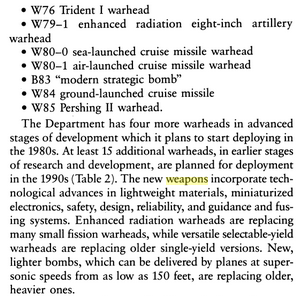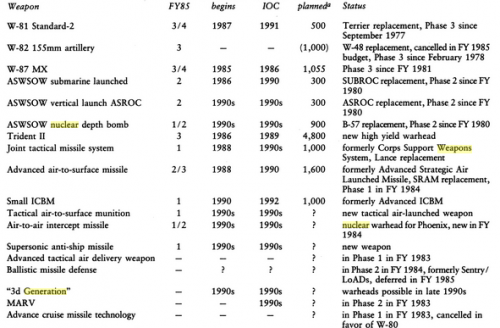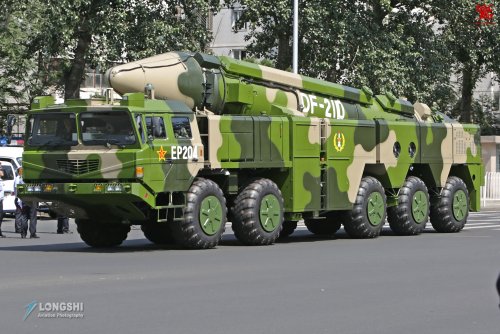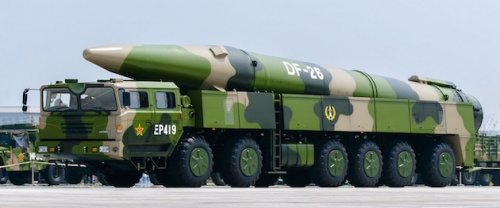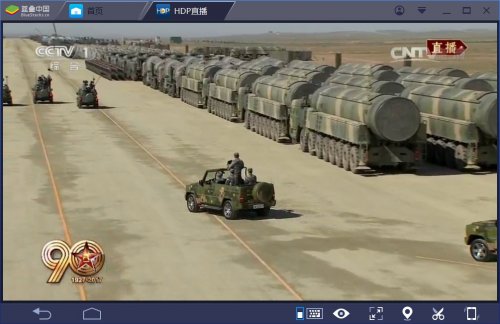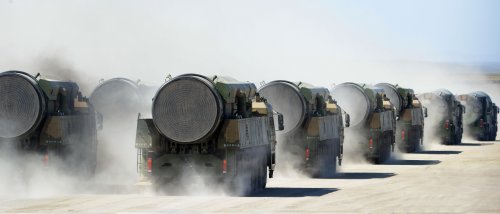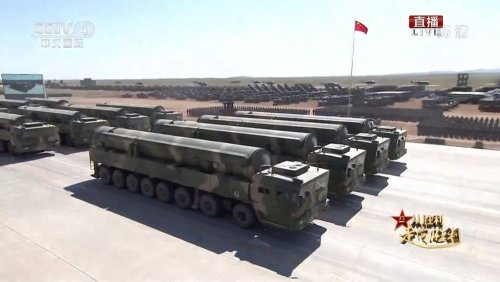You are using an out of date browser. It may not display this or other websites correctly.
You should upgrade or use an alternative browser.
You should upgrade or use an alternative browser.
Nuclear Weapons - Discussion.
- Thread starter sferrin
- Start date
- Status
- Not open for further replies.
lastdingo
Blogger http://defense-and-freedom.blogspot.de/
This piece is in my responsibility:
http://defense-and-freedom.blogspot.de/2017/07/proposal-for-partial-nuclear.html
http://defense-and-freedom.blogspot.de/2017/07/proposal-for-partial-nuclear.html
- Joined
- 3 June 2011
- Messages
- 17,332
- Reaction score
- 9,067
lastdingo said:This piece is in my responsibility:
http://defense-and-freedom.blogspot.de/2017/07/proposal-for-partial-nuclear.html
Oh, wow. Yeah, I'm sure Russia and China will jump all over that. Those gales of laughter you hear are Russia and China laughing as yet another Westerner argues for putting their heads on the block.
lastdingo
Blogger http://defense-and-freedom.blogspot.de/
sferrin said:lastdingo said:This piece is in my responsibility:
http://defense-and-freedom.blogspot.de/2017/07/proposal-for-partial-nuclear.html
Oh, wow. Yeah, I'm sure Russia and China will jump all over that. Those gales of laughter you hear are Russia and China laughing as yet another Westerner argues for putting their heads on the block.
You seem to be unaware of the current size of the Chinese nuclear arsenal http://www.icanw.org/the-facts/nuclear-arsenals/ - or do you think having ~250 nukes in face of thousands of American and thousands of Russian nukes is preferable over having 100 nukes in face of 200 American and 200 Russian nukes?
Either way - I disagree, obviously.
- Joined
- 21 April 2009
- Messages
- 13,169
- Reaction score
- 6,054
http://www.nipp.org/2017/07/17/ruhle-hans-and-michael-ruhle-contours-of-a-third-nuclear-age/
http://www.realcleardefense.com/articles/2017/07/19/the_nuclear_posture_review_bomber_capability_and_extended_deterrence_111843.html
http://www.realcleardefense.com/articles/2017/07/19/the_nuclear_posture_review_bomber_capability_and_extended_deterrence_111843.html
- Joined
- 3 June 2011
- Messages
- 17,332
- Reaction score
- 9,067
lastdingo said:sferrin said:lastdingo said:This piece is in my responsibility:
http://defense-and-freedom.blogspot.de/2017/07/proposal-for-partial-nuclear.html
Oh, wow. Yeah, I'm sure Russia and China will jump all over that. Those gales of laughter you hear are Russia and China laughing as yet another Westerner argues for putting their heads on the block.
You seem to be unaware of the current size of the Chinese nuclear arsenal http://www.icanw.org/the-facts/nuclear-arsenals/ - or do you think having ~250 nukes in face of thousands of American and thousands of Russian nukes is preferable over having 100 nukes in face of 200 American and 200 Russian nukes?
Either way - I disagree, obviously.
Except that's not what you'd get. You'd get 200 American nukes, as we unilaterally disarmed, in the face of thousands of Russian nukes and (let's be real here) thousands of Chinese nukes (they are continuing to add nuclear weapons to their forces). And aren't you Australian anyway?
lastdingo
Blogger http://defense-and-freedom.blogspot.de/
I'm not, and the history of the START treaties shows that your claim is lacking any substantiation in all relevant episodes of history.
A slow violation of the limits wouldn't yield much of an "advantage" before detected by the surveillance regime.
And again, we have lots of history showing that such surveillance regimes work and were & are trusted. Save for Neocon idiots and their toy poodle, and they were proven wrong.
You make up thousands of Chinese nukes (practically all sources claim they have about 200-300 WITHOUT ANY evidence.
You assert certain violations of the proposed treaty would happen WITHOUT ANY substantiation.
I understand it's your opinion and I respect that, but yours is a worthless opinion on this issue.
A slow violation of the limits wouldn't yield much of an "advantage" before detected by the surveillance regime.
And again, we have lots of history showing that such surveillance regimes work and were & are trusted. Save for Neocon idiots and their toy poodle, and they were proven wrong.
You make up thousands of Chinese nukes (practically all sources claim they have about 200-300 WITHOUT ANY evidence.
You assert certain violations of the proposed treaty would happen WITHOUT ANY substantiation.
I understand it's your opinion and I respect that, but yours is a worthless opinion on this issue.
lastdingo said:I'm not, and the history of the START treaties shows that your claim is lacking any substantiation in all relevant episodes of history.
A slow violation of the limits wouldn't yield much of an "advantage" before detected by the surveillance regime.
And again, we have lots of history showing that such surveillance regimes work and were & are trusted. Save for Neocon idiots and their toy poodle, and they were proven wrong.
You make up thousands of Chinese nukes (practically all sources claim they have about 200-300 WITHOUT ANY evidence.
You assert certain violations of the proposed treaty would happen WITHOUT ANY substantiation.
I understand it's your opinion and I respect that, but yours is a worthless opinion on this issue.
You don't seem to be aware that it is now Russian military doctrine to utilize a limited nuclear strike using low-yield high precision weapons, euphemistically named "escalate to de-esclate", then threaten a massive nuclear strike to get an opponent to back down. Sorry to burst your bubble, but we're back to Mutually Assured Destruction (MAD) as a doctrine of military strategy and national security policy.
lastdingo
Blogger http://defense-and-freedom.blogspot.de/
Well, I wrote about that way of doing things before on my blog, so I'm aware of it, but 200 10-100 kt nukes are easily enough for such a strategy as well. You can knock out half of the Polish and German armies in the field with 20 such nukes and still have enough left to destroy or ruin most if not all of the 150 biggest cities in US, UK and France and even have dozens of nukes left afterwards.
Besides, changed circumstances would likely lead to changed doctrines. That's implied in the concept and would actually be an upside of the proposed treaty.
A bigger (and real) issue is that the U.S. would have to give up BMD and thus would have to rely on deterrence against NK instead of hoping on defences (that could be circumvented by covert delivery in peacetime anyway). So the U.S. would kinda have to give up more than Russia, which would make convincing real hard.
Besides, changed circumstances would likely lead to changed doctrines. That's implied in the concept and would actually be an upside of the proposed treaty.
A bigger (and real) issue is that the U.S. would have to give up BMD and thus would have to rely on deterrence against NK instead of hoping on defences (that could be circumvented by covert delivery in peacetime anyway). So the U.S. would kinda have to give up more than Russia, which would make convincing real hard.
- Joined
- 21 April 2009
- Messages
- 13,169
- Reaction score
- 6,054
http://www.heritage.org/missile-defense/commentary/defense-authorization-bills-advance-us-missile-defense-and-nuclear?utm_source=facebook&utm_medium=social&utm_campaign=thf-fb
Some good news on nukes but they also need to change the language in the NDAA with regard to the national labs that are currently forbidden from R&Ding new warhead types. We must remain on the cutting edge of all things nuclear.
Some good news on nukes but they also need to change the language in the NDAA with regard to the national labs that are currently forbidden from R&Ding new warhead types. We must remain on the cutting edge of all things nuclear.
marauder2048
"I should really just relax"
- Joined
- 19 November 2013
- Messages
- 3,157
- Reaction score
- 776
lastdingo said:This piece is in my responsibility:
http://defense-and-freedom.blogspot.de/2017/07/proposal-for-partial-nuclear.html
Basing conventionally powered ballistic missile submarines in the Great Lakes was examined in detail in 1980.
Hydrographic and climatic considerations would restrict operations to Superior, Michigan and Huron.
And the areas of those lakes with sufficient depth in which to operate are actually small enough that
even a blind barrage using a few hundred warheads of strategic yield would likely destroy the entire force.
In practice, the amount of shipping and air traffic in the region would provide suitable cover for coarse grain
detection techniques that would likely eliminate the need for a blind barrage.
On the containers for the reserve warheads/decoys: they would need to be hardened to silo/shelter level
i.e. able to withstand a conventional attack with the contents would likely need to be exchanged periodically
to preserve locational uncertainty.
But in this scheme, it would seem more profitable to attack the reserve launchers themselves which
unless they are nearly as proliferated as the decoys would become the chokepoint.
lastdingo
Blogger http://defense-and-freedom.blogspot.de/
Marauder, you seem to ignore that the proposal limits the qty of warheads available for offensive, disarming action.
marauder2048
"I should really just relax"
- Joined
- 19 November 2013
- Messages
- 3,157
- Reaction score
- 776
lastdingo said:Marauder, you seem to ignore that the proposal limits the qty of warheads available for offensive, disarming action.
The proposal encourages cheating because what you thought was a survivable basing mode
in the Great Lakes is in fact highly vulnerable to even modest increases in the number of warheads.
And a cheating attacker would have first mover advantage in terms of beginning
the process of mating the reserve warheads to their launchers.
Brickmuppet
ACCESS: Secret
http://www.scmp.com/news/china/diplomacy-defence/article/2103880/china-gives-glimpse-advanced-missile-and-launch-system
I can't find much more on the DF-31AG.
I can't find much more on the DF-31AG.
- Joined
- 21 April 2009
- Messages
- 13,169
- Reaction score
- 6,054
Latest Dept. of State New Start numbers
https://www.state.gov/t/avc/newstart/272337.htm
IIRC these are roughly the opposite from when the treaty was signed. We are down about 400 warheads and Russia is up around 400 warheads.
Russian strategic modernization is for a post New START world. All their new systems large MIRV potential combined with nuclear enterprise still capable of build 1000+ warheads/annum compared to our 15.
https://www.state.gov/t/avc/newstart/272337.htm
IIRC these are roughly the opposite from when the treaty was signed. We are down about 400 warheads and Russia is up around 400 warheads.
Russian strategic modernization is for a post New START world. All their new systems large MIRV potential combined with nuclear enterprise still capable of build 1000+ warheads/annum compared to our 15.
- Joined
- 3 June 2011
- Messages
- 17,332
- Reaction score
- 9,067
bobbymike said:Latest Dept. of State New Start numbers
https://www.state.gov/t/avc/newstart/272337.htm
IIRC these are roughly the opposite from when the treaty was signed. We are down about 400 warheads and Russia is up around 400 warheads.
Russian strategic modernization is for a post New START world. All their new systems large MIRV potential combined with nuclear enterprise still capable of build 1000+ warheads/annum compared to our 15.
Nothing to worry about. What could possibly go wrong?
Attachments
- Joined
- 9 October 2009
- Messages
- 19,955
- Reaction score
- 10,456
https://www.nytimes.com/2017/07/29/world/asia/us-south-korea-north-korea-missile-test.html
- Joined
- 21 April 2009
- Messages
- 13,169
- Reaction score
- 6,054
From Defense One - "The D Brief"
China has a new ICBM, and it made sure the world could see it on Beijing state TV Sunday, "marking the 90th anniversary of the founding of the force that is now known as the People's Liberation Army," The Wall Street Journal reports. "It is the first time a parade has been held to mark the anniversary since 1949, according to state media, and is the latest in a series of moves that analysts say are designed to boost Mr. Xi's political standing in the run-up to a reshuffle of the party leadership this year."
What viewers saw: "State television showed at least 16 DF-31AG missiles in Sunday's parade at the Zhurihe combat-training base in northern China... The DF-31AG is mounted on an all-terrain vehicle so it is harder to track and can be fired from multiple locations, and it could have a longer range than the older DF-31A
China has a new ICBM, and it made sure the world could see it on Beijing state TV Sunday, "marking the 90th anniversary of the founding of the force that is now known as the People's Liberation Army," The Wall Street Journal reports. "It is the first time a parade has been held to mark the anniversary since 1949, according to state media, and is the latest in a series of moves that analysts say are designed to boost Mr. Xi's political standing in the run-up to a reshuffle of the party leadership this year."
What viewers saw: "State television showed at least 16 DF-31AG missiles in Sunday's parade at the Zhurihe combat-training base in northern China... The DF-31AG is mounted on an all-terrain vehicle so it is harder to track and can be fired from multiple locations, and it could have a longer range than the older DF-31A
- Joined
- 3 June 2011
- Messages
- 17,332
- Reaction score
- 9,067
bobbymike said:From Defense One - "The D Brief"
China has a new ICBM, and it made sure the world could see it on Beijing state TV Sunday, "marking the 90th anniversary of the founding of the force that is now known as the People's Liberation Army," The Wall Street Journal reports. "It is the first time a parade has been held to mark the anniversary since 1949, according to state media, and is the latest in a series of moves that analysts say are designed to boost Mr. Xi's political standing in the run-up to a reshuffle of the party leadership this year."
What viewers saw: "State television showed at least 16 DF-31AG missiles in Sunday's parade at the Zhurihe combat-training base in northern China... The DF-31AG is mounted on an all-terrain vehicle so it is harder to track and can be fired from multiple locations, and it could have a longer range than the older DF-31A
We should probably get rid of our ICBMs because China isn't doing anything with their nuclear forces and Russia is only
- Joined
- 21 April 2009
- Messages
- 13,169
- Reaction score
- 6,054
http://freebeacon.com/national-security/stratcom-worried-slow-pace-u-s-nuclear-modernization/
Yes it's mine as well
And yet there are those who call it too expensive and want to cut even deeper.
http://deepcuts.org/images/PDF/DeepCuts_WP10_ReifMizin.pdf
:
"My biggest concern is the ability to go fast enough," Hyten said.
The modernization will take between 12 and 18 years depending on the triad of systems—land-based intercontinental ballistic missiles, submarines and missiles, and nuclear bombers.
Yes it's mine as well
"But I just keep pointing out the fact that this is not new technology. This is not pushing the state of the art in many ways," he said.
For example, Hyten said that in five years beginning in the late 1950s, the Pentagon built and deployed 800 Minuteman I ICBMs at five bases in new silos, and created new command and control systems. The cost in current dollars was $17 billion.
"So how is it that we could do it in five years back then?" Hyten asked
Russian nuclear force modernization includes a rapid buildup of several new missiles with multiple warheads, missile submarines, and bombers. Moscow has announced the force will be 70 percent upgraded by 2020. Moscow is spending $560 billion on the modernization.
"Whether they get there or not, I won't comment on, but that was a stated objective, and I'll just point out that in 2020, we'll be zero percent modernized," Hyten said.
_________________________________________________________________"But I have to have a nuclear weapons enterprise that continues to produce the nuclear weapons and maintain the nuclear weapons I need and the next 10 Stratcom commanders need in order to provide that capability," he said. "So there has to be work done in modernization of the nuclear capabilities. I want to do that in a way that does not require testing. That creates a significant challenge for the laboratories as well."
And yet there are those who call it too expensive and want to cut even deeper.
http://deepcuts.org/images/PDF/DeepCuts_WP10_ReifMizin.pdf
:
- Joined
- 3 June 2011
- Messages
- 17,332
- Reaction score
- 9,067
bobbymike said:And yet there are those who call it too expensive and want to cut even deeper.
http://deepcuts.org/images/PDF/DeepCuts_WP10_ReifMizin.pdf
:
That whole mentality. . .they're either grossly uninformed or actually WANT the US to fall.
- Joined
- 21 April 2009
- Messages
- 13,169
- Reaction score
- 6,054
http://www.realcleardefense.com/articles/2017/08/03/us_nuclear_strategy_in_the_face_of_chinas_rise_111960.html?utm_source=RC+Defense+Morning+Recon&utm_campaign=e3bffd10cb-EMAIL_CAMPAIGN_2017_08_02&utm_medium=email&utm_term=0_694f73a8dc-e3bffd10cb-81812733
However, with the end of the Soviet threat, the U.S. took a “strategic holiday” and permitted its nuclear force structure to atrophy, as it lived off the “nuclear capital” it accumulated during the Cold War.
- Joined
- 21 April 2009
- Messages
- 13,169
- Reaction score
- 6,054
I attached these to a Tweet to the NNSA, Energy Department and the National Labs. What was happening 33 years ago.sferrin said:And it's still doing it. Too many people think that nuclear weapons have infinite life and have no concept whatsoever about things like, "industrial base", "lead times" and "tribal knowledge".
Attachments
- Joined
- 21 April 2009
- Messages
- 13,169
- Reaction score
- 6,054
Deterrence Strategy Looks More Than 20 Years in the Future
Vice Chairman of the Joint Chiefs of Staff Gen. Paul Selva, speaking Thursday at an AFA Mitchell Institute event on Capitol Hill, said a nuclear posture review has never projected threats beyond a sitting administration until now. Staff photo by Gideon Grudo.
—Gideon Grudo
Nuclear deterrence is the Defense Department’s “most important mission,” according to the US military’s second highest-ranking officer.
Speaking on Capitol Hill Thursday morning, Vice Chairman of the Joint Chiefs of Staff USAF Gen. Paul Selva outlined the military’s capabilities, challenges, and concerns as it moves forward with its nuclear deterrence enterprise. Many of these are being studied in conjunction with and as part of the nuclear posture review (NPR) and the ballistic missile defense review (BMDR), which President Donald Trump ordered earlier this year, and which Selva is leading.
Selva said the department is taking a “unique” approach to the NPR, noting it will be “tailored” to the requirements of current and emerging 21st century threats and look out over 20 years into the future.
“This will be the first time that we have projected the threat out beyond the current administration and provided advice to a sitting President on how we should tailor our nuclear enterprise and our ballistic missile defense enterprise to ensure the defense of the nation,” Selva said at the talk, hosted by the AFA Mitchell Institute. From radical approaches to conservative ones, the recommendations to the President will leave “everything on the table.”
There are other significant milestones to consider, leaving the military in uncharted waters, Selva added.
“This is only our second ballistic missile defense review,” he said. “It’s only our fourth nuclear posture review. It’s the first time in the history of either that the threat actually got worse in the intervening years between the last review and the current.”
Unlike it did in its first NPR—conducted in 1994—and in all other BMDRs, this time the military “can’t afford” to assume that over the life of the reviews, and their coinciding actions, existing threats would diminish, Selva said.
In claiming the nuclear mission is DOD’s most important, Selva argued three points. For one, Selva said nuclear weapons pose “the only existential threat” to the US and its allies, saying there’s “no substitute for a devastating nuclear response to deter that threat.” Second, the country’s nuclear triad “complicates the adversary’s preemptive strike calculus and it allows us to hedge against both internal and external uncertainties.” Third, Selva said, deterrence, assurance, and escalation control are what allow “the nuclear enterprise to support our national US military objectives.”
“If you don’t believe one or all of those three propositions,” Selva said, “Sleep is a valid form of criticism.”
The reviews will take into account four specific nation-states that pose or are expected to pose a threat to the US: Russia, China, North Korea, and Iran. Despite these threats, Selva said the military is “not on a quest to have a Cold War-style arms race with any opponent,” but on a path to replace the structure that exists within today’s nuclear enterprise with “new equipment.” He shies away from using the term modernization, arguing “replacement” is more accurate and is a “consequence” of a “more modern” enterprise.
“It won’t be cheap. Today we spend about 3.5 percent of the defense budget on the ownership and maintenance of our existing nuclear force,” Selva said, adding that “given the current set of budget constraints,” that number will rise to “just over six percent.”
Nothing changes the fact that, “While we’re buying new, we must maintain old,” he said.
Vice Chairman of the Joint Chiefs of Staff Gen. Paul Selva, speaking Thursday at an AFA Mitchell Institute event on Capitol Hill, said a nuclear posture review has never projected threats beyond a sitting administration until now. Staff photo by Gideon Grudo.
—Gideon Grudo
Nuclear deterrence is the Defense Department’s “most important mission,” according to the US military’s second highest-ranking officer.
Speaking on Capitol Hill Thursday morning, Vice Chairman of the Joint Chiefs of Staff USAF Gen. Paul Selva outlined the military’s capabilities, challenges, and concerns as it moves forward with its nuclear deterrence enterprise. Many of these are being studied in conjunction with and as part of the nuclear posture review (NPR) and the ballistic missile defense review (BMDR), which President Donald Trump ordered earlier this year, and which Selva is leading.
Selva said the department is taking a “unique” approach to the NPR, noting it will be “tailored” to the requirements of current and emerging 21st century threats and look out over 20 years into the future.
“This will be the first time that we have projected the threat out beyond the current administration and provided advice to a sitting President on how we should tailor our nuclear enterprise and our ballistic missile defense enterprise to ensure the defense of the nation,” Selva said at the talk, hosted by the AFA Mitchell Institute. From radical approaches to conservative ones, the recommendations to the President will leave “everything on the table.”
There are other significant milestones to consider, leaving the military in uncharted waters, Selva added.
“This is only our second ballistic missile defense review,” he said. “It’s only our fourth nuclear posture review. It’s the first time in the history of either that the threat actually got worse in the intervening years between the last review and the current.”
Unlike it did in its first NPR—conducted in 1994—and in all other BMDRs, this time the military “can’t afford” to assume that over the life of the reviews, and their coinciding actions, existing threats would diminish, Selva said.
In claiming the nuclear mission is DOD’s most important, Selva argued three points. For one, Selva said nuclear weapons pose “the only existential threat” to the US and its allies, saying there’s “no substitute for a devastating nuclear response to deter that threat.” Second, the country’s nuclear triad “complicates the adversary’s preemptive strike calculus and it allows us to hedge against both internal and external uncertainties.” Third, Selva said, deterrence, assurance, and escalation control are what allow “the nuclear enterprise to support our national US military objectives.”
“If you don’t believe one or all of those three propositions,” Selva said, “Sleep is a valid form of criticism.”
The reviews will take into account four specific nation-states that pose or are expected to pose a threat to the US: Russia, China, North Korea, and Iran. Despite these threats, Selva said the military is “not on a quest to have a Cold War-style arms race with any opponent,” but on a path to replace the structure that exists within today’s nuclear enterprise with “new equipment.” He shies away from using the term modernization, arguing “replacement” is more accurate and is a “consequence” of a “more modern” enterprise.
“It won’t be cheap. Today we spend about 3.5 percent of the defense budget on the ownership and maintenance of our existing nuclear force,” Selva said, adding that “given the current set of budget constraints,” that number will rise to “just over six percent.”
Nothing changes the fact that, “While we’re buying new, we must maintain old,” he said.
- Joined
- 9 October 2009
- Messages
- 19,955
- Reaction score
- 10,456
A spark of sanity? Or just an illusion?
- Joined
- 3 June 2011
- Messages
- 17,332
- Reaction score
- 9,067
So glad China isn't increasing it's nuclear forces. Surely our MMIII fleet, the newest of which rolled off the line in 1977, will last forever. /sarc
Attachments
- Joined
- 21 April 2009
- Messages
- 13,169
- Reaction score
- 6,054
http://www.defenseone.com/technology/2017/08/us-military-eyes-new-mini-nukes-21st-century-deterrence/139997/?oref=defenseone_today_nl
It is with a sad and heavy heart for me to believe nothing will ever get beyond discussions at a pro-nuke meeting held in Washington.
We really are at the point of requiring a Manhattan Project '21' a crash program to completely overhaul and modernize the nuclear enterprise as if, like in WWII, our national survival depended on it.
It is with a sad and heavy heart for me to believe nothing will ever get beyond discussions at a pro-nuke meeting held in Washington.
We really are at the point of requiring a Manhattan Project '21' a crash program to completely overhaul and modernize the nuclear enterprise as if, like in WWII, our national survival depended on it.
- Joined
- 3 June 2011
- Messages
- 17,332
- Reaction score
- 9,067
bobbymike said:http://www.defenseone.com/technology/2017/08/us-military-eyes-new-mini-nukes-21st-century-deterrence/139997/?oref=defenseone_today_nl
It is with a sad and heavy heart for me to believe nothing will ever get beyond discussions at a pro-nuke meeting held in Washington.
We really are at the point of requiring a Manhattan Project '21' a crash program to completely overhaul and modernize the nuclear enterprise as if, like in WWII, our national survival depended on it.
The problem is we have whole generations who've never experienced a real war and are completely oblivious. They can't conceive of the US ever being attacked no matter how weak we get. To them it's as much a fantasy as Santa Claus. And many of them are politicians in Washington.
- Status
- Not open for further replies.


